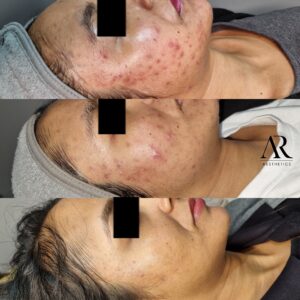When it comes to any skin condition, the key is hydration always! whether its acne, pigmentation or oily skin. Essentially having hydration allows the skin to heal better and this works by preventing trans-epidermal water loss. Trans-epidermal water loss is when the barrier is broken and the skin loses moisture and therefore cannot heal, when you use cleansers that strip away all the moisture from the skin, this removes all the oils which triggers the over production of sebum which then fills up in the pores as excess oil production and when you initially strip the oils you allow the dead skin cells to build up. This causes the excess build up of dead skin to clog the pores with the excess sebum production which is now a nice moist area for bacteria to grow and therefore leads to infection, blackheads and whiteheads.
When it comes to treating acne i find that adding moisture rather than removing excess oils doesn’t help the skin long term. I know most of you feel as if drying the skin will actually help you but unfortunately it just makes it worse. You just allowing more bacteria as well as more scarring, pigmentation, premature aging and so much more especially if you’re skin of colour. When the skin remains hydrated, treatments and products tend to work more effectively. Your skin tends to take better to active ingredients and results are seen much faster. Your skin also tends to be more sensitive which will reduce if the barrier of your skin is healthier.
Wondering how to effectively address hormonal acne, scarring, and sensitivity all at once?
It was definitely a process that starts with a personalized skin consultation. My approach to skincare involves tailoring a unique treatment plan for each client, although it’s important to note that it’s not always a straightforward path. Treating complex skin issues often involves some trial and error.
Consider one of my clients who battled severe hormonal acne, characterized by redness and inflammation, mainly around the lower half of the face. This indicated a hormonal link to the acne. Alongside her demanding work schedule, she lacked proper skincare guidance. Initially, we recommended medication—an antibiotic—to address the issue internally without harming her skin. However, she had an allergic reaction to the medication, revealing a sulfur allergy.
This setback led us to devise an alternative treatment plan, which took longer due to the absence of internal medication support. Central to this plan was restoring her skin’s barrier, a critical step before tackling scarring, redness, and inflammation. Strengthening her skin barrier not only prepared it for subsequent treatments but also aided in scar and pigmentation reduction. Remember, a healthy skin barrier makes treatment and product absorption more effective, particularly for individuals with skin of color.
Our journey began by rebuilding her skin’s barrier with a product called scar repair. This product played a vital role in strengthening her skin and preparing it for further treatments. After two weeks, we introduced chemical peels containing salicylic acid to decongest pores, combat bacteria, and reduce excess oil secretion—essential ingredients for penetrating deep into the pores.
As we witnessed a decline in inflammation, we progressed to micro-needling (or dermapen treatment) paired with a skin peel. Conducting the peel before micro-needling optimized product penetration and worked with the fresh skin layer on the surface, yielding superior results. Given the severity of her skin issues, multiple sessions were required.
Subsequently, we combined the peel and micro-needling treatments. This step, however, was delayed due to her sensitivity and the need for extensive healing and preparation. Adequate skin preparation is essential before any robust treatment or product application. We customized her home skincare routine based on her specific concerns, which complemented the in-office treatments and aided her skin’s healing process.
Her skin transformation spanned 11 months of dedication and
perseverance. Now, we maintain her skin health with monthly or bimonthly sessions and consistent product usage, ensuring her skin stays healthy and radiant. This journey underscores the importance of a personalized, adaptable approach to skincare, especially when dealing with complex skin concerns.
Subsequently, we combined the peel and micro-needling treatments. This step, however, was delayed due to her sensitivity and the need for extensive healing and preparation. Adequate skin preparation is essential before any robust treatment or product application. We customized her home skincare routine based on her specific concerns, which complemented the in-office treatments and aided her skin’s healing process.
Her skin transformation spanned 11 months of dedication and perseverance. Now, we maintain her skin health with monthly or bimonthly sessions and consistent product usage, ensuring her skin stays healthy and radiant. This journey underscores the importance of a personalized, adaptable approach to skincare, especially when dealing with complex skin concerns.

